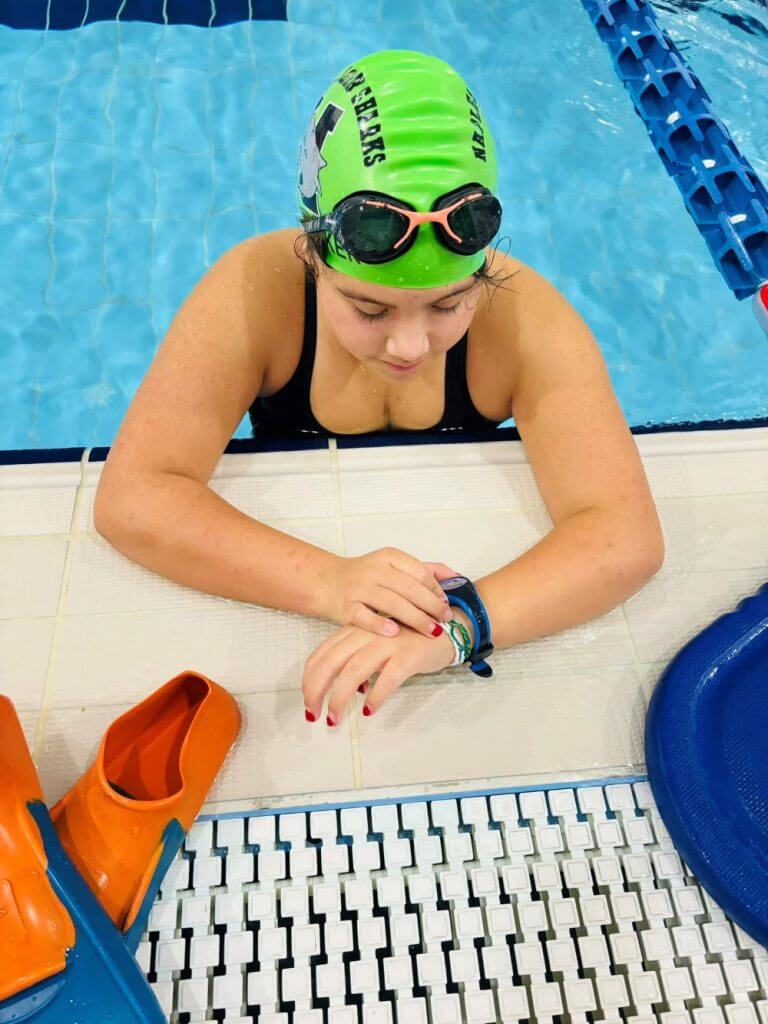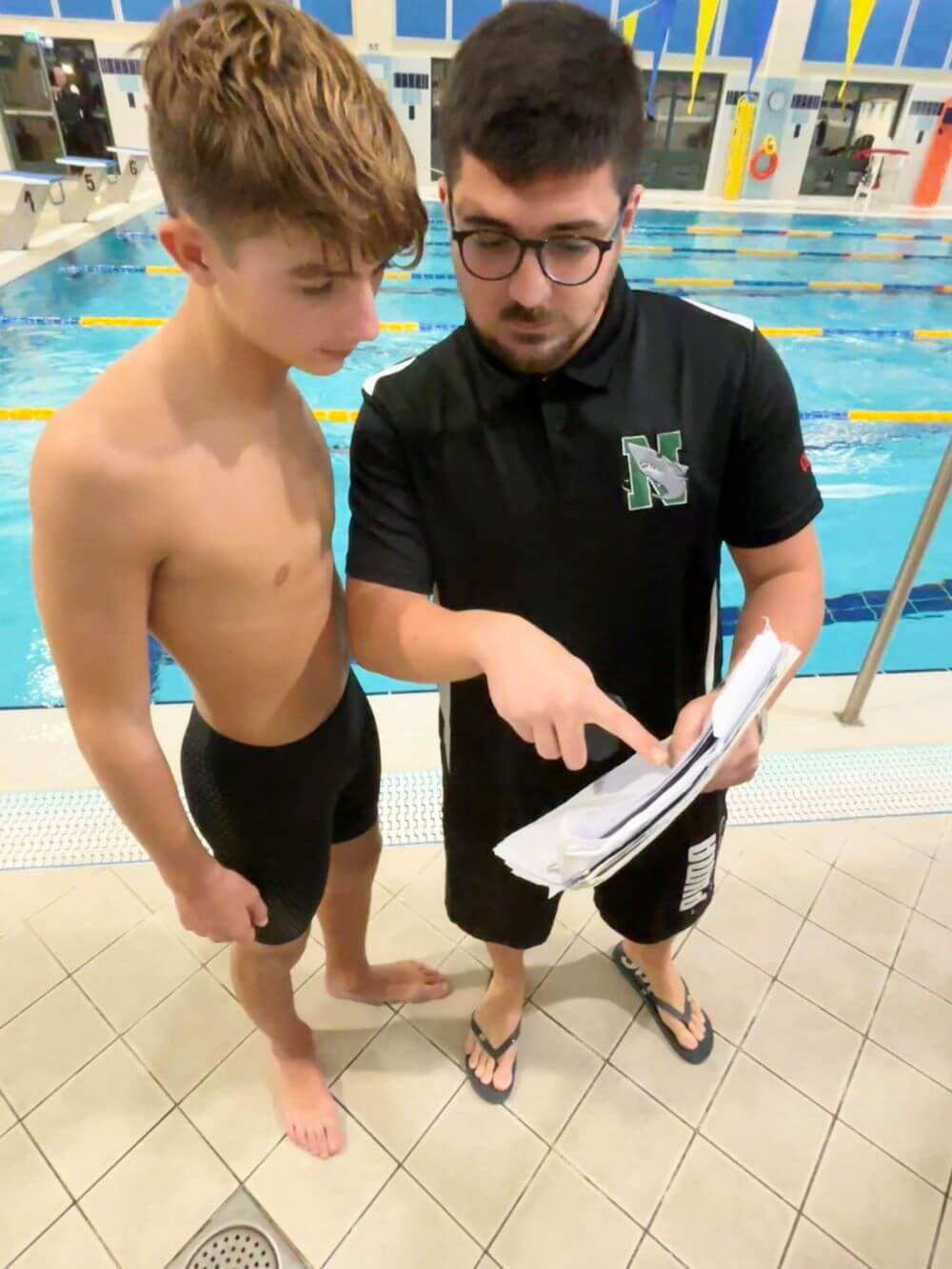Tech Tuesday: The Evolution of Technology in Competitive Swimming

Tech Tuesday: The Evolution of Technology in Competitive Swimming
By Reed Karosich and Isabel Hromas
In the ever-evolving world of technological progress, sports, particularly competitive swimming, has become a focus for innovation. The swimming world is witnessing a surge in advancements aimed at boosting athlete performance. With the introduction of cutting-edge gadgets, athletes are experiencing a shift in training methods and performance analysis. We decided to explore the dynamic relationship between technology and competitive swimming, shedding light on the latest advancements that are reshaping the way athletes approach their training and the overall foundation of aquatic sports.
Much of the newest performance technology is being used by professional teams and universities who are prepared to spend the money for even the slightest advantage. A few new gadgets being employed include FINIS Swimsense fins, and the Garmin Swim. These devices can identify everything from the swimmer’s lap time to the stroke the swimmer was performing. These valuable tools can collect information and then analyze the swimmer’s overall performance. The information collected from this technology can allow swimmers, coaches, and even AI (Artificial Intelligence) machine learning models to identify ways to improve their work outs.
Aided by computers, skilled coaches can identify almost any flaw, weakness, strength, reflex, or strategy, ultimately, allowing them to map the ideal stroke for a swimmer’s body, stamina, and energy output. This technology can prescribe precise sets, custom engineered to highlight the swimmer’s strengths, or examine their weaknesses. This type of feedback is essential for improvement. It enables coaches and swimmers to collaborate to enhance performance and empower swimmers.

For high school and club teams with smaller budgets, coaches can still use the benefit of technology and analytics. Taking images and videos of the swimmer’s strokes, streamlines, turns, and dives can provide the swimmer with comprehension that typical verbal analysis cannot. Many individuals carry a capable camera right in their pockets, embedded in their smartphones. This functionality allows coaches to advise swimmers on areas for improvement while also graphically demonstrating certain components they may be doing poorly. For underwater images and videos, a simple GoPro or cell phone in a water-tight case can provide a clear view from the water. Larger teams might be able to afford a limited number of swim monitors, like the Finis Swimsense, and lend them out to their most competitive swimmers.
The Finis SwimSense is a swim performance monitor designed to provide swimmers with detailed information about their workouts. This device uses a sensor that captures data during swim sessions. The data acquired includes lap count, total distance, lap time, strokes per lap, and calories burned. It is also equipped with automatic stroke recognition and data transfer capability, all packaged with a waterproof design and user-friendly interface. Another option is a Swim Mirror, which, while less technologically advanced, allows swimmers to see how they are moving in the water and watch as they adjust their stroke. A full-sized mirror would lay on the bottom of the pool and the swimmer would be tied to a bungee. This would hold the swimmer in place above the mirror as they watch themselves in real time, correcting or refining their technique.
The most dedicated swimmers are continually looking for methods to improve; after a certain point, human resources might become limited. The new technology has the potential to help these swimmers develop much more. If teams collected money to buy equipment for their top swimmers, they could provide these athletes with tools that their competitors might not be able to match. If a team can’t afford these luxuries, coaches can film the swimmer’s performance and run it through an AI Learning tool or even a college-level coach for guidance on how to assist the swimmer’s development. The AI Machine Learning tool would analyze a swimmer’s stroke, watch their every detail, and compile the learned data into a graph. It can provide general advice on how to improve technique, or study how a swimmer’s stroke changes as they get tired throughout a long event. Identifying these tiny details will prompt easy, quick, and effective fixes to take a swimmer to the next level. Incorporating AI could be a tremendous game changer, resulting in a new and exciting era of swimming.
Swimming technology can also improve safety. Swim monitors that detect heart rate and warn coaches in real time could make hypoxic training, as well as regular and taper workouts, safer by notifying coaches before, during, and after SWB (Shallow Water Blackouts) or other injuries. Every year, roughly 140,000 people worldwide die because of drowning. Although there are limited reliable statistics for SWB, it is estimated that SWB is responsible for up to 20% of all drownings. If the implementation of this technology prevented just one of these events, it’s value would be immeasurable.
In conclusion, the integration of wearable technology in swimming not only provides valuable insights for individualized training but also serves as a powerful tool for coaches and athletes alike. The ability to identify patterns and refine swimming techniques through continuous feedback is a game-changer. Video recordings and wearable device input not only help coaches but also offer a level of precision that may stump the human eye. The arrival of AI machine learning further enhances this capability, detecting subtle trends that contribute to overall performance improvements. Most importantly, these technologies act as a preventive measure, sounding the alarm against potential dangers from over-exertion. As we stand on the brink of technological advancements, these tools are either at our fingertips or just on the horizon, promising a future where swimming performance is optimized, and risks are minimized.



